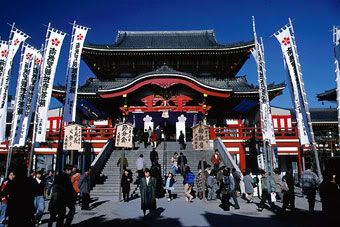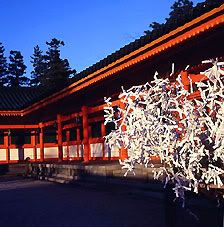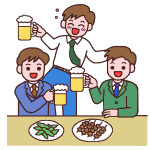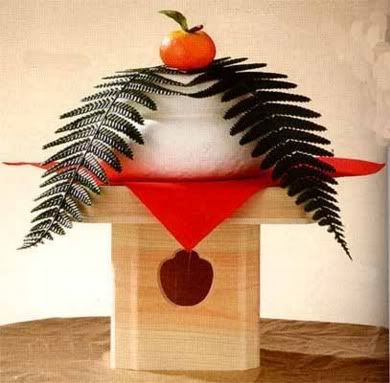|
|
|
|
|
|
|
|
|
 Posted: Mon Dec 28, 2009 3:43 pm Posted: Mon Dec 28, 2009 3:43 pm
Shogatsu - Japanese New Year
Let's learn something new!

2010 will be the year of the tiger. Those of you who were born in the year of the tiger, you'll have completed another zodiac cycle! One cycle is 12 years. Don't know if you're the year of the tiger? People born in 1914, 1926, 1938, 1950, 1962, 1974, 1986, 1998, or 2010 are tigers. (The exception being people born in January and occasionally February as the zodiac corresponds to the Chinese New Year which starts after the start of the western calendar.) This year, the Chinese new year starts on February 14th, Valentine's Day, making it doubly auspicious.
"Tiger people are sensitive, given to deep thinking, capable of great sympathy. They can be extremely short-tempered, however. Other people have great respect for them, but sometimes tiger people come into conflict with older people or those in authority. sometimes Tiger people cannot make up their minds, which can result in a poor, hasty decision or a sound decision arrived at too late. They are suspicious of others, but they are courageous and powerful."
Fortune:
"For the tiger in 2010, any recent setbacks or obstacles can be overcome, so look forward to a year in which to really shine, either personally or professionally. "
Post 1: Zodiac year & Index
Post 2: Traditions
Post 3: Traditions cont.
Post 4: Decorations
Post 5: Recipes
|
 |
 |
|
|
|
|
|
|
|
|
|
|
|
|
 Posted: Mon Dec 28, 2009 3:48 pm Posted: Mon Dec 28, 2009 3:48 pm
New Year Traditions
Nengajo - New Year cards
Nen (year) ga (greeting) jo (card)

This is a card from 2009, the year of the ox.
Nengajo are similar to the western tradition of Christmas cards. People write and send cards before New Years wishing family and friends health and happiness in the new year. There is one major difference though. Nengajo are delivered strictly on January 1st. The cards are post cards and have a specific format that allows the postal service to easily identify them. The cards are held by the postal service until January 1st and delivered with the mail on the first day of the new year. They are often zodiac themed and this year will depict tigers.
Hatsumode - First Temple Visit

Hatsumode is the Japanese custom of visiting a shrine for the first time in the new year. This is part of a traditional new year celebration. Shrines are often very crowded on New Year's Eve and New Year's Day. Roughly 80 million people visit a shrine for New Year's. People drop a coin into the saisenbako, or collection box, and clap twice, and bow before offering up their prayer. Some say the clapping is to get the attention of the gods.

After praying, people can purchase an omikuji, or fortune. Many people choose to tie their omikuji onto a tree so that it can be blessed by the shinto gods.

Ema, or wooden plaques can also be purchased so that you can write you wish for the new year. These wishes range from desires to pass entrance exams, to asking for the love of a significant other, to wishes for peace.
Traditional Clothes

For many young women, the first shrine visit of the new year is one of the few opportunities they have to wear a nagasode, a formal long sleeved kimono. In order to keep warm, these young ladies are wearing fur stoles.
For men, New Year's dress can be as formal as a suit and tie. I believe that this is more common than kimono for men. (please correct me if I'm wrong!)
|
 |
 |
|
|
|
|
|
|
|
|
|
|
|
|
|
|
|
 Posted: Mon Dec 28, 2009 4:29 pm Posted: Mon Dec 28, 2009 4:29 pm
New Year Traditions Continued
New Year's Games
Hanetsuki - Japanese Badminton
 
This is a game played with hagoita or paddles and a hane or brightly coloured shuttlecock. The idea is to keep the ball in the air. Who ever lets the ball drop is punished by having their face drawn on with india ink. Traditionally, the longer the shuttlecock is kept in the air, the more protection the players will have from mosquitoes in the coming year. The game has lost popularity but you can still find decorative hagoita sold. It is not uncommon to find them with popular characters or celebrities on them. If you look at the picture above, Mokona has been punished twice!
Takoage -kite flying

Flying kites is a new year tradition that there isn't much information about. I guess it's just people flying kites because it's fun?
Karuta - a card game

Karuta is a game that, when played by rambunctious high schoolers, can turn rather violent. There are 200 cards in a deck: 100 yomifuda or reading cards, and 100 torifuda or grabbing cards. The torifuda have the first character or kanna of a poem and the yomifuda have poems on them. The torifuda are spread out on the floor and players sit around the cards. One person reads a yomifuda which has a poem written on it. The players then must find the matching torifuda. This game is good practice when learning kanna.
New Year's Foods
Toshikoshi Soba

Toshikoshi soba, or buckwheat noodles, are often served on New Year's as a sign of longevity.
Osechi Ryori

During the New Year celebration, osechi ryori is served. Osechi ryori is made up of a variety of dishes with significance for the New Year.
daidai (橙) - a bitter orange: symbolizes a wish for children in the new year
datemaki (伊達巻 or 伊達巻き) - a sweet rolled omelette: symbolizes a wish for many auspicious days
kamaboko (蒲鉾) - broiled fish paste: the colour and shape is reminiscent of the rising sun
kazunoko (数の子) - herring roe: symbolizes a wish to be gifted with numerous children in the new year
konbu (昆布) - seaweed: it is associated with the word yorokobu, meaning "joy"
kuro-mame (黒豆) - black soybeans: symbolizing a wish for health in the new year
tai (鯛) - red sea-bream: it is associate with the word medetai, symbolizing an auspicious event
tazukuri (田作り) - dried sardines cooked in soy sauce: symbolizes and abundant harvest
zoni (雑煮) - a soup of mochi rice cakes in clear broth: symbolism unknown
Otoso or Toso - Spiced Sake

Toso is a spiced medicinal sake that is traditionally drunk during new year celebrations to flush away the previous year's maladies and to aspire to lead a long life. It is flavored with Japanese pepper, asiasari radix, apiaceae, cinnamon, dried ginger, atractylodes Japonica, Chinese bellflower and rhubarb.
Fukubukuro - Lucky Bag

These are bags sold by merchants that are filled with random items at a substantial discount. These bags sell quickly and there are sometimes lines to get into stores that are selling them. Fukubukuro started as a way for merchants to get rid of old products since it is bad luck to begin the new year with unwanted trash from the previous year. It has since become a way for merchants to draw customers to their stores.
Bonenkai - Year Forgetting Parties

These are drinking parties with coworkers or friends. The purpose, as the name implies, is to forget about the troubles of the previous year. This is usually done by getting ridiculously drunk. These parties are usually held in December.
|
 |
 |
|
|
|
|
|
|
|
|
|
|
|
|
 Posted: Mon Dec 28, 2009 4:30 pm Posted: Mon Dec 28, 2009 4:30 pm
New Year Decorations
Kagami Mochi

One traditional decoration is the Kagami Mochi (鏡餅) which is formed from two mochi cakes with a daidai (橙, bitter orange) on top. Daidai means 'several generations' and because of this it is considered to be good luck.
Kodomatsu

This is a decoration placed on both sides of a gate or outside of doorways to bring the year god. They are made of three bamboo stalks, pine branches, and straw. Pine is a symbol of longevity.
|
 |
 |
|
|
|
|
|
|
|
|
|
|
|
|
|
|
|
 Posted: Mon Dec 28, 2009 4:33 pm Posted: Mon Dec 28, 2009 4:33 pm
New Year Recipes
Basic Mochi (courtesy of Chow.com)

This is the sweet version of our Basic Savory Mochi. The addition of corn syrup allows the dough to remain soft, even when wrapped around ice cream. Though untraditional, if you have some leftover, try them toasted under the broiler for a few minutes.
* 1 1/2 cups mochiko, plus more for dusting
* 1/2 teaspoon kosher salt
* 1 1/3 cups water
* 1/4 cup granulated sugar
* 2 tablespoons light corn syrup
1. Place mochiko and salt in a large bowl and stir until thoroughly combined.
2. Combine water, sugar, and corn syrup in a medium saucepan and bring to a boil over medium-high heat. Reduce to a simmer and cook, stirring, until sugar is dissolved, about 5 to 6 minutes.
3. Make a well in the center of the mochiko mixture and pour in the sugar syrup. Stir until all flour is incorporated. Immediately turn dough onto a work surface lightly floured with mochiko and knead until smooth and elastic, about 4 to 5 minutes; dust with more mochiko as needed to prevent sticking.
4. Pinch off tablespoon-size pieces and, using a floured rolling pin or your hands, flatten into 3-inch circles about 1/8 inch thick.
5. Dust rice cakes with mochiko and place on a baking sheet lined with parchment paper. Cover in plastic wrap and store in the refrigerator or freezer, or use as desired.
Mochi can be filled with a variety of things. Often times they are filled with azuki bean (red bean) paste. I've even seen some that are filled with a strawberry and azuki bean paste.

|
 |
 |
|
|
|
|
|
|
|
|
|
|
|
|
 Posted: Mon Dec 28, 2009 7:31 pm Posted: Mon Dec 28, 2009 7:31 pm
I'd like to thank my friend Bryan for his contributions. His facebook posts have been thoroughly informative!
First sunrise of 2010 over Tokyo Tower:

Inside Bryan's Lucky Bag!

Inside Bryan's Lucky Box!

|
 |
 |
|
|
|
|
|
|
|
|
|
|
|
|
|
|
|
 Posted: Mon Dec 28, 2009 7:33 pm Posted: Mon Dec 28, 2009 7:33 pm
I hope you all learned something new! Please share your New Year traditions!
|
 |
 |
|
|
|
|
|
|
|
|
|
|
|
|
 Posted: Fri Jan 01, 2010 1:32 pm Posted: Fri Jan 01, 2010 1:32 pm
That was really interesting info, I was born during the year of the rat but I'm not sure when the next year of the rat is...
For New Years, I just stay home and watch the ball drop on television..but this year I fell asleep TEN MINUTES before it dropped....I'm so bummed.
|
 |
 |
|
|
|
|
|
|
|
|
|
|
|
|
|
|
|
 Posted: Fri Jan 01, 2010 1:45 pm Posted: Fri Jan 01, 2010 1:45 pm
awesomesara822 That was really interesting info, I was born during the year of the rat but I'm not sure when the next year of the rat is...
For New Years, I just stay home and watch the ball drop on television..but this year I fell asleep TEN MINUTES before it dropped....I'm so bummed.
Well, how old are you now? You can do the math to find out the next year of the rat.
So we start with your year.
My brother is a rat so I'll use his birth year: 1984
Add 12 = 1996
Add 12 = 2008
Add 12 = 2020
Since there are 12 animals in the zodiac, you can find the years for an animal by adding 12 to it's last known year.
Also, the great thing about New Years is that it happens every year! Try again next year! Good luck!
|
 |
 |
|
|
|
|
|
|
|
|
|
|
|
|
 Posted: Fri Jan 01, 2010 1:52 pm Posted: Fri Jan 01, 2010 1:52 pm
I was born in 1996, I'm young sweatdrop
So 2020 is the next year of the rat? I'll be waiting...
|
 |
 |
|
|
|
|
|
|
|
|
|
|
|
|
|
|
|
 Posted: Fri Jan 01, 2010 2:04 pm Posted: Fri Jan 01, 2010 2:04 pm
awesomesara822 I was born in 1996, I'm young sweatdrop
So 2020 is the next year of the rat? I'll be waiting...
Yup! It's a ways off. But hey, you'll be 24! I'm an Ox. My next year will be in 2021. I'll be super old (36) by then!
|
 |
 |
|
|
|
|
|
|
|
|
|
|
|
|
 Posted: Sat Jan 02, 2010 5:55 am Posted: Sat Jan 02, 2010 5:55 am
I didn't do anything this year since everyone was out of town but usually I have a party at my house with good food and good company. Next year I want to have a Japanese themed party!
*
There is definitely enough Japanese New Year items here to make a girl happy!
|
 |
 |
|
|
|
|
|
|
|
|
|
|
|
|
|

Strawberry Pocky Parade Vice Captain
|
 Posted: Sat Jan 02, 2010 11:35 am Posted: Sat Jan 02, 2010 11:35 am
It was really fun reading this thread. biggrin It was like a storybook. I had heard abotu some of the traditions but not others. :3 Hurray for learning, right? xD I wish we had some sort of tradition here for the new year, you know? Other than just watching a ball drop in New York...and drinking. xD;
|
 |
 |
|
|
|
|
|
|
|
|
|
|
|
|
 Posted: Sat Jan 02, 2010 1:32 pm Posted: Sat Jan 02, 2010 1:32 pm
Wow, that was alot of amazing information. I knew enough about the food, clothing and kites (Edit: and the wishes as well), but I didn't know about the game. And you even gave a good recipe for mochi (I like kiwi filling alot on mine).
But what about the mooncakes? I could of sworn they were made for the New Year as well (or is that China? Sometime I mix up asian traditions sweatdrop )
|
 |
 |
|
|
|
|
|
|
|
|
|
|
|
|
|
|
|
 Posted: Sat Jan 02, 2010 1:54 pm Posted: Sat Jan 02, 2010 1:54 pm
Well, in the spirit of the new year,
あけましておめでとうございます!
Hope everyone has a wonderful and fun 2010, and the start of a new and exciting new decade!
|
 |
 |
|
|
|
|
|
|
|
|
 |
|
|
|
|
|
|

























